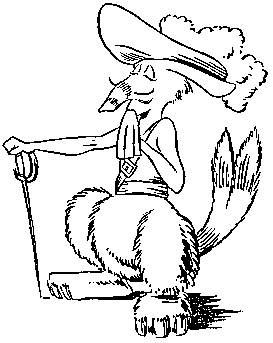If it's Niagara Falls, it must be the Gathering
Pevans attends this year's convention
My report is written as a narrative to be read through and focuses on the games I played, as well as the social side of the Gathering. You can use the indexes below to take you to specific sections or games.
It is also available as a PDF document: Gathering of Friends 2018 report (3 Mb). (You will need Adobe Reader to view this document – use the link to download it if necessary.)
- List of games played
- 1: Getting started – and back to Mars
- 2: New World and North Pole
- 3: India, caves and pirates
- 4: Civilization!
- 5: Rosenberg and Stockhausen
- 6: Flea Market, prizes and more games
- Wrapping up on Sunday
- About the Gathering
- Beer at the Gathering
List of games mentioned
| Title | Designer | Publisher | Rating |
|---|---|---|---|
| 1500: The New World | Dan Verssen | Dan Verssen Games | 5* |
| Alien Artifacts | Marcin Senior Ropka and Viola Kijowska | Portal | 6 |
| Altiplano | Reiner Stockhausen | dlp Games | 7* |
| Chariots of Rome | Sean Young | Victory Point Games | 5* |
| Civilization/Advanced Civilization | Francis Tresham | Hartland Trefoil/Avalon Hill | 11 |
| Clans of Caledonia | Juma Al-JouJou | Karma Games | 7* |
| Downforce | Wolfgang Kramer | Iello/Restoration Games | 7 |
| Exxtra | Reiner Knizia | Amigo | 8 |
| Heaven & Ale | Michael Kiesling and Andreas Schmidt | eggertspiele | 8 |
| John Company | Cole Wehrle | Sierra Madre Games | 9* |
| Keyper | Richard Breese | R&D Games | 7 |
| Little Devils | Michael Feldkötter | Stronghold Games/White Goblin Games | 6* |
| Medici: the card game | Reiner Knizia | Grail Games | 8 |
| Memoir '44 (Overlord) | Richard Borg | Days of Wonder | 8 |
| Nusfjord | Uwe Rosenberg | Lookout/Mayfair Games | 8* |
| Path of Light and Shadow | Travis Chance, Jonathan Gilmour and Nick Little | Indie Boards and Cards | 6* |
| Rajas of the Ganges | Inka and Markus Brand | R&R Games | 8 |
| Santa's Workshop | Keith Ferguson | Rio Grande Games | 7* |
| Terraforming Mars | Jacob Fryxelius | Fryx Games | 7 |
| Tortuga 1667 | Travis Hancock | Façade Games | 6* |
| Vast: the Crystal Caverns | Patrick Leder and David Somerville | Leder Games | 6* |
| Viral | Gil d'Orey and Antonio Sousa Lara | MESA Boardgames | 8 |
| Viticulture (Essential edition) | Jamey Stegmaier and Alan Stone | Stonemaier Games | 9 |
| * Provisional rating based on playing just once | |||
About the Gathering
This year’s event was the 29th Gathering of Friends, which started out as a weekend get-together by a bunch of gamers, led by Alan Moon (now well known as the designer of Airlines, Elfenland, Ticket to Ride et al). The following year they did it again, bringing some friends with them. This is the abiding principle of the Gathering of Friends: everybody who comes is a friend (and is invited by Alan). This makes for a very convivial, relaxed atmosphere in which anyone can walk up to anyone and ask to join or start a game. Never mind six degrees of separation, at the Gathering it’s hard to find someone more than two away.
Over the years, the Gathering has expanded in time and space – and moved, too, arriving in Niagara Falls in 2011. Games designers bring prototypes to test and games publishers attend. However, the emphasis remains on playing games and having fun. The event would be recognisable to anyone who’s attended a UK convention. It consists of people playing games – most of which they’ve brought with them. I always have a good time and meet up with old friends – and new.
1: Getting started – and back to Mars
My journey to Niagara Falls was pleasantly uneventful this year. I took in a couple of films on the flight - switching on the subtitles makes a big difference when the aeroplane noise is drowning out the dialogue. I flew to Toronto again and even US immigration on the rainbow bridge (just below the Falls) was pretty efficient.
And, late on a Monday evening, after a transatlantic flight and a couple of hours' in a shuttle bus, what could be better than a game of Terraforming Mars? I blame Pete Card. Shades of last year when this was also the first game I played at the Gathering. Last year was my introduction to the game and this felt like an introduction again as I haven't actually played it since. The difference was that we (Pete, me and Jonathan Yost) played on the Hellas board. This didn't seem to make much difference, apart from having different goals to achieve. Last year's experience stood me in good stead and it was a close game. Though every time I grew a few plants, Jonathan landed an asteroid on them! He took the win with Pete pushing me back into third by a point. Despite my tiredness, this was definitely my best experience of Terraforming Mars to date. It was also more than enough for my first evening.
2: New World and North Pole
In best American style (as I think of it) breakfast is taken outside the hotel. So, on Tuesday morning Pete and I hit our usual: the Third Street Retreat. This is a bar/diner a couple of blocks along from the hotel (I would usually say "a couple of minutes' walk", but I'm going native) that does all-day breakfast. Fortified by a bowl of oatmeal (aka porridge)/pile of pancakes/plate of eggs, bacon and toast, we returned to the hotel - through light snowfall - in search of games.
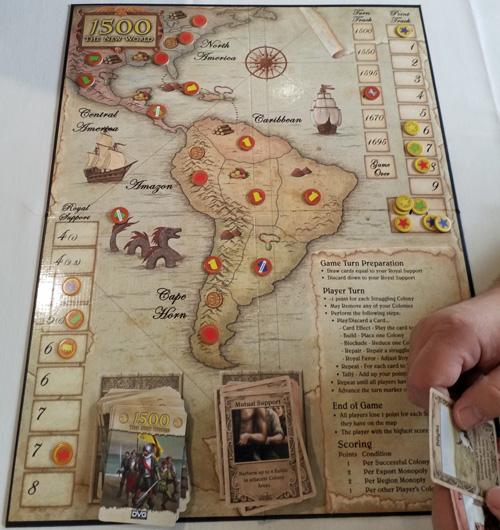
Pondering the next move in 1500:The New World
Our old gaming buddy Jim Vroom invited us to join him and Brian Stallings for 1500: the New World (designed and published by Dan Verssen). This is a card-driven game of colonising the new world, with the players as different European nations. It's a quick fire game with stuff appearing and disappearing all the time. Each turn, you play your cards to create scoring opportunities, but without any great expectation that these will survive until your next turn. There's a lot of "take that", but no engine-building. We reckoned the last player (which doesn't change once the game has started) has an advantage, so we're surprised that they got a better starting position as well. The game's several expansions are decks of cards, giving each nation their own, different deck, rather than all drawing from the same one. It was fun to play, but not a game I feel I need to play again. I give 1500: the New World a provisional 5/10 on my highly subjective scale.
As the person who'd played Keyper once, I had explaining duties for our next game - Jim McMahon replacing Brian. This is the latest of Richard Breese's Key... games (published by Richard's imprint, R&D Games) and, like several of the others, is all about placing your worker pawns (keyples) to take actions. In this game you start with a set of keyples in different colours, each providing a bonus when played on a space of the same colour. However, the way the game works, it's very unlikely that you'll pick up a similar mixture of keyples for the next round. Part of the challenge is managing the pawns you have from round to round.
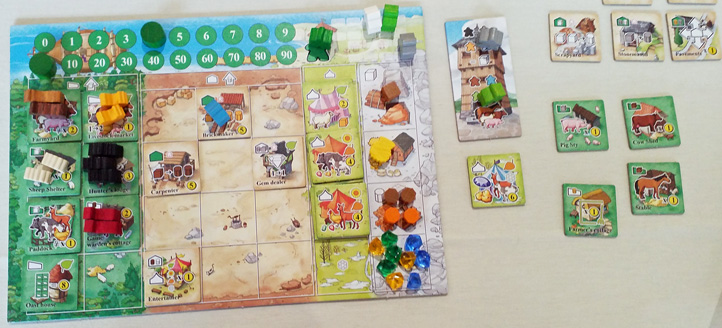
My player board (green) and tiles during Keyper: lots of animals (on the left), but not so many buildings
Placing a keyple lets you take materials, animals or gems, construct or upgrade buildings (tiles) and add new building tiles to your available stock. The clever bit is that another player can join you in the same action by adding their keyple of the same colour to the action space. Both players get to do the action - twice. What's more, if the keyples are the same colour as the space, they both get the bonus action. Hence, joining benefits both players. If you join a lot of actions, you'll run through your keyples more quickly, but this is often a good thing.
Buildings are key to the game as they provide extra actions and/or victory points - either in themselves or for other things you hold at the end of the game. Thus, while you start without any strategic goals, once you've got scoring buildings, you've got something to collect. A round ends when the last player has played their last pawn. However, players who've already used theirs are not out of the round: they can lay down pawns to take that action again. With the bonuses.
The game is played over four rounds (seasons) and the boards you're playing on (one per player) are reconfigured at the start of each season, gradually changing the actions available. I was very taken with Keyper when I first played it, but have found it a bit fiddly on subsequent plays. It's a game where you can feel frustrated all the way through - because you can't do what you want to - and still win. It gets 7/10 on my highly subjective scale.
Picking up a coffee at Starbucks (the hotel no longer has any in-house catering - it's all franchises), I joined Pete and a couple more gaming buddies, Maryl Fischer and Julie Luxenberg, to play Heaven & Ale. This is one of eggertspiele's games from 2017, designed by Michael Kiesling and Andreas Schmidt. I actually played the pre-production game at last year's Gathering and thus couldn't talk about at the time. It originally took me some time to work out that title is a pun: the game is about monks brewing beer.
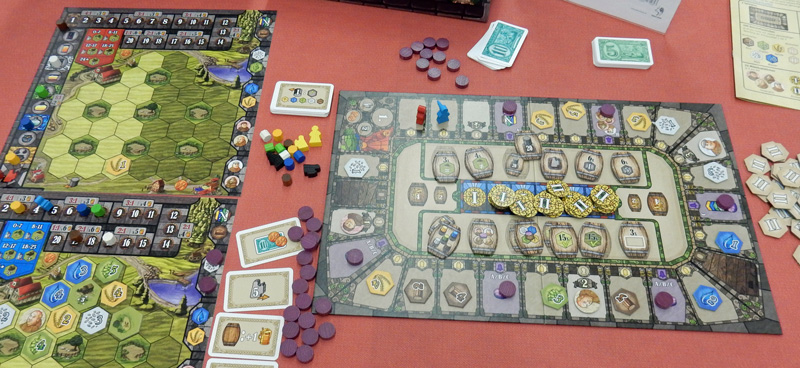
Heaven & Ale on display at Spiel ‘17
I've already written about this game. So let me just say that it takes a while to get the hang of the game, but it then flows well. There are lots of decisions to make, all of which feel important, and plenty of factors to weigh up. I have played it a few times now and feel I've finally got to grips with it. Heaven & Ale gets 8/10 on my highly subjective scale.
Julie joined Pete and me for dinner at TGI Friday (there's this and a Rainforest Café in the hotel), after which we caught up with Kris Gould, another old gaming buddy (and main man at Wattsalpoag). He introduced us to Santa's Workshop (designed by Keith Ferguson and published by Rio Grande). Each player has a set of pawns which they deploy on the various sections of the board to get the cubes needed to complete the sets that will let them take a target card and score points. The cards are gifts, the pawns are elves and, yes, we're making presents for Santa to deliver!
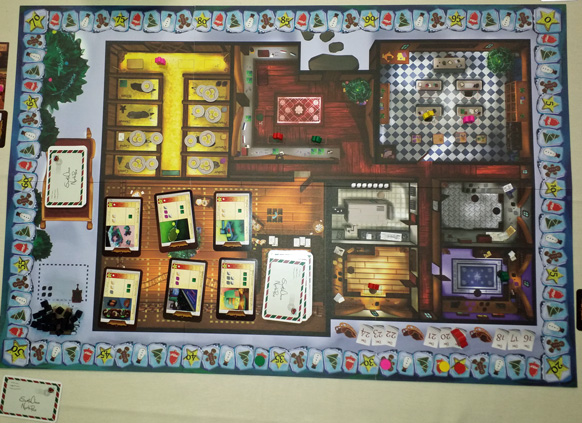
Look: it’s Santa’s Workshop! Workshop areas on the right, gift requests bottom left
with the stables top left and the loaded sleigh (almost) on the left edge
It's actually a pleasingly subtle game as there are several wrinkles in this basic structure. First off, gifts also need to be assembled. It's not enough simply to collect the right materials. Second, plastic can be substituted for some parts of many gifts. However, this devalues the gift, so it doesn't score as much - though players do have the option of replacing the plastic later. Thirdly, players can train their elves, making them more effective in a particular section of the workshop. Finally, elves can be deployed to the stables to muck out Rudolf and co - and get a bonus or extra action.
Apart from scoring for completed gifts, there are three times in the game when players get bonuses for having completed the most gifts. There's nothing particularly new here, it's a pretty straightforward worker placement game. However, the mechanisms mesh well together, giving players decisions to make and opportunities to impede their opponents. What really makes the game, though, is the entertaining theme. I give Santa's Workshop a provisional 7/10 on my highly subjective scale.
3: India, caves and pirates
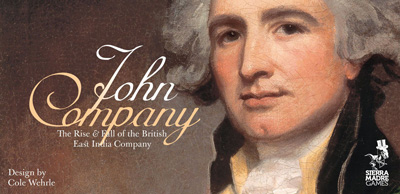 After breakfast on Wednesday Pete and I joined Ralph Anderson and Simon Weinberg for my introduction to John Company. Designed by Cole Wehrle and published by Sierra Madre, this is a game of the British
East India Company. Each player represents a family whose members (wooden cubes) work for the company in different roles. The aim is to earn money from company dividends and personal activities (officers in the company's army, captains of company ships etc) to be able to afford a luxurious retirement (or victory points, in game terms).
After breakfast on Wednesday Pete and I joined Ralph Anderson and Simon Weinberg for my introduction to John Company. Designed by Cole Wehrle and published by Sierra Madre, this is a game of the British
East India Company. Each player represents a family whose members (wooden cubes) work for the company in different roles. The aim is to earn money from company dividends and personal activities (officers in the company's army, captains of company ships etc) to be able to afford a luxurious retirement (or victory points, in game terms).
After promoting people to fill any vacancies, each round follows the structure of the company as its officers carry out their duties. Chief of these is, of course, taking over India. The 'Presidents' in each region use the resources and money they've been allocated to trade with Indian territories, generating revenue for the company (and the President), or to conquer them. Successfully conquering a territory brings plunder for the military officers assigned and establishes a new company office in the gift of the President.
There is a definite element of back-scratching in the game and players are encouraged to negotiate. In particular, John Company has a mechanism of 'promises'. If, for example, a player promotes one of his own cubes ahead of other players' cubes, they must give a 'promise' (cube) to each of the others. If still held by another player at the end of the game, this is a penalty on the player's victory points. However, promises can be traded between players, bought back for cash or redeemed by promoting the holding player's cube. This is a neat little mechanism that adds a lot to the game (and reminds me of the obligations in Alan Paull's Confucius).
One point to note is that, for many of the actions (such as trading with an Indian territory), success is not automatic. Dice must be rolled, with the result of the action depending on the lowest value rolled. As a '1' or '2' is a success, rolling more dice increases players' chances. Committing more resources (such as ships, troops or money) to an action adds more dice, so players must decide how much to commit. The bottom line is that an action can fail, regardless of how much is committed to it and this luck element is significant in how the game develops.
On top of this, there are events - in India and Britain - each round that can change the shape of the game. Then the last thing each round is seeing which office-holders retire. This is when players get the opportunity to turn their cash into victory points, so it's a crucial element of the game. However, retirement depends on a die roll, which means a player with a pile of cash may simply be unable to turn it into points. It's a shame that such a key part of the game is so luck dependent. Still, I find John Company a fascinating mix of co-operative and competitive play and a terrific experience. It gets a provisional 9/10 on my highly subjective scale.
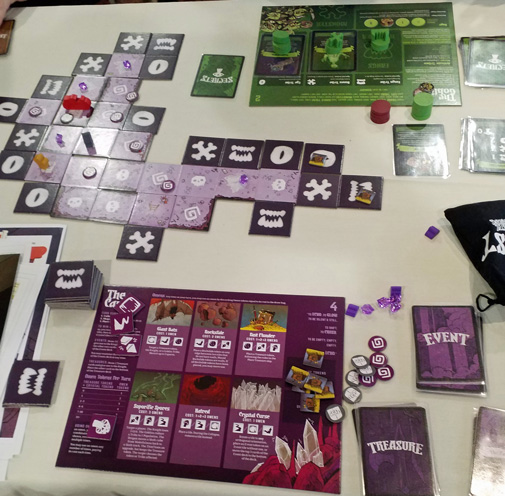
Vast seen from over the Cave’s shoulder: purple is his stuff, the tiles in the middle
are the caverns and the green board is the pesky Goblins
One of the highlights of the Gathering for me is getting to play a game with Steffan O'Sullivan. Steffan is a lovely fellow and a delight to play games with. Pete and I joined him plus Dan and Heather Hoffman to play Vast: the Crystal Caverns (designed by Patrick Leder and David Somerville and published by Leder Games). At first glance, this appears to be a dungeon bash. However, it's a completely asymmetric game, which makes it rather more.
So, the Dragon (me) is asleep in its treasure cave. Its aim is to wake up fully (eating Goblins helps) and then leave the caves to wreak havoc elsewhere (I can hear a lake-dwelling community calling to me...). The Knight (Pete) wants to kill the dragon, but must find the weaponry to do so first. The Goblin tribes (Heather) want to kill the Knight, but keep being scattered by other characters. The Thief (Dan) wants to grab treasures, but they're useful to everybody else, too. And the Cave (Steffan) wants everybody to die! This means collapsing the caverns so that nobody can get out, but not until the whole complex has been explored (i.e. all the tiles laid out).
Each of the characters has their own sheet explaining their victory conditions, the actions available to them (and when they can use them) and their special abilities. This led to a lot of cross-checking and verifying as we learnt the game. It turned out to be a close game (apart from Pete's Knight, who had been thoroughly stuffed by the Goblins): the Thief needed one more treasure, the Cave was close to full collapse, the Goblins had the Knight on her knees - and the fully-awake Dragon escaped!
Vast: the Crystal Caverns is an interesting game and a clever take on the dungeon bash. However, we found there was nothing to do when it wasn't your turn - apart from the Cave adding new tiles as others explored. This was no doubt exacerbated by having five players learning the game, but it also had less interaction than expected. The strategy seemed to be to get your head down and concentrate on your own goals. It gets a provisional 6/10 on my highly subjective scale.
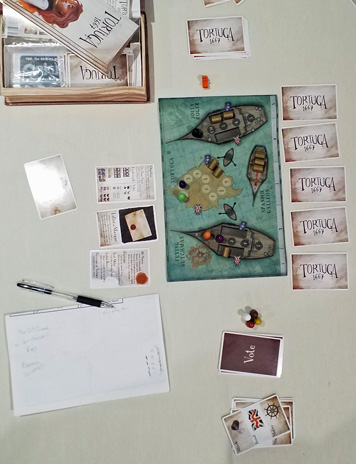
Tortuga 1667 in play: the board shows two pirate ships,
the galleon they’re preying on and the island of Tortuga itself
Our after-dinner game was Tortuga 1667, for which Steffan, Pete and I were joined by Julie again and Jacqui Bankler. Cunningly packed in a box that looks like a book, this was designed by Travis Hancock and published by Façade Games. As the name suggests, this is a game about pirates. In fact, there are teams of pirates, but players' allegiances are hidden. Two of the teams are competing to gain the most treasure, while the third wants an even balance between the other two.
Key to the game is the row of face-down Event cards. Players can use their turn's action to look at these, resolve one or make someone else resolve one. Some of the cards are helpful; others are quite the opposite, so looking at them first is the safe way to proceed. Players can also move between the two pirate ships and the island of Tortuga. There are also special actions for the pirate who has a particular role on a ship - captain or cabin boy, say.
What you're doing, of course, is trying to get the treasure pieces into the right places, depending on what team you're on. At the same time, you want to identify your team-mate/s so that you can help them and hinder the others. By, for example, continually marooning them on Tortuga. Not that I'm bitter... Tortuga 1667 was fun, but didn't really grab me, so it gets a provisional 6/10 on my highly subjective scale.
4: Civilization!
Thursday featured one of my highlights of this year's Gathering: a full game of Civilization, the greatest game in the universe! Marred only by Jim Vroom calling a 9 am start (well, it was his game) and the fact that we were actually playing Advanced Civilization (developed by Avalon Hill from Francis Tresham's original game). (The changes in 'Advanced' make the game more forgiving and add a bit more luck. Or, as I usually put it: make it easier for Americans.) Nevertheless, it was great to have the time and people to play a full game.
We had six players (me, Pete, and Jim plus the irrepressible Walter Hunt, the not-sleepy-at-all Ravindra Prasad and my old Battle Cry and Memoir '44 sparring partner, Leo Tischer) and played with the Western expansion, thus giving us plenty of room. Given the last choice of starting position, I went for Babylon. So my civilisation developed in the Tigris-Euphrates area, expanding to the Mediterranean coast to meet Egypt (Walter) coming the other way. Less usually, I also had pressure from Assyria (Pete) on the other side, trying to make room between Babylon and Illyria (Leo), who was expanding into Asia Minor. In retrospect, it was probably a bad idea for three of us to start in one quarter of the board, letting the other three have a quarter each.
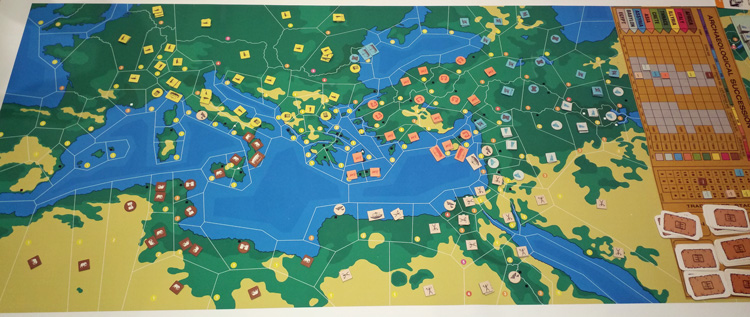
An early stage of Civ: Babylon (light blue) has dropped behind and Assyria (mid blue) is being squeezed
As Babylon I deliberately took an early hit, in part to keep pieces on the board to be able to respond to Pete. However, things didn't go well and Babylon fell further behind, putting me out of the running. What brought me back into the game was Pete getting a Civil War (it's a calamity) and having to give me the benefit of it (some of his pieces). However, the core of any game of Civilization is the trading between players and this was great fun, with calamity cards being traded to good effect.
After 6½ hours playing (and an hour for lunch), it was a close result between Leo (Illyria), Ravindra (Italy) and Walter (Egypt). Babylon was just behind these three with Pete's Assyria and Jim's Africa bringing up the rear. It was, as always, great fun to play. Who knows, maybe we'll make a regular event. For the record, Civilization gets 11/10 on my highly subjective scale.
After this, I needed some light relief and Joe Huber (another old gaming buddy) roped in me and Mark Engleberg to try a very silly prototype from Friedemann Friese. Now, the first rule of playing prototypes is that you don't talk about the prototype, so I won't. However, it was very silly - to the extent that Friedemann reckoned it probably wouldn't make a publishable game. We had fun, though.
I then bumped into more old friends - Jim McDanold, Carl Olson and John Garnett - and joined them to try Downforce (published by Iello). This is the 2017 variation of Wolfgang Kramer's game whose previous incarnations include Formel 1, Top Race and Detroit-Cleveland Grand Prix. It's a car racing game where players' cards move several cars. The trick is to still end up moving the cars you prefer further than the others - having cars block the track is a very useful way of wasting good moves for other cars.
However, they game is won and lost by which cars you back. Betting on the winner from the start is the way to go, regardless of which player is nominally in control of that car - though they also get prize money. Despite its many versions, the game has been out of print for some 20 years and this new edition is a 'restoration' by Restoration Games. Downforce remains good fun and gets 7/10 on my highly subjective scale.
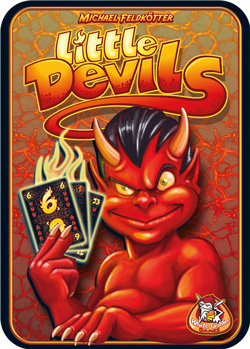 Returning from dinner I found Maryl and her other half, Nick Ramsey, settling down to a game of Little Devils with Mike Allen, one of the first people I ever met at the Gathering, and Jenna Sunderlin. The game is better the more people who are playing, so we roped in Carl Olson as well. Designed by Michael Feldkötter and published by White Goblin
and Stronghold, Little Devils dates back to 2012, but this was the first time I'd come across it.
Returning from dinner I found Maryl and her other half, Nick Ramsey, settling down to a game of Little Devils with Mike Allen, one of the first people I ever met at the Gathering, and Jenna Sunderlin. The game is better the more people who are playing, so we roped in Carl Olson as well. Designed by Michael Feldkötter and published by White Goblin
and Stronghold, Little Devils dates back to 2012, but this was the first time I'd come across it.
It's a neat little card game where the aim is to minimise the number of little devil icons on the cards in the tricks you take. The deck is simply number cards and, with six players, all of them are dealt out. The first player leads any card. The second player plays any card. However, the second card determines what players are trying to do. If it's higher than the first card, everybody is playing a card higher than the first and the highest card wins the trick. If it's lower, then everybody's playing lower and the lowest card wins. Unless anybody can't play a valid card, in which case they may play anything, but the winner of the trick is reversed (lowest wins instead of highest or vice versa).
After the hands have been played out, players tot up their penalty points and play another hand. The game ends when someone reaches 100 points and the player with the lowest score wins. I got the first hand spectacularly wrong, scoring over half the magic 100, but managed to recover so that the game lasted several hands. Little Devils is a nice little game that has obvious resonances with 6 nimmt!, but I think it has more control than that game. I thoroughly enjoyed the game - and the company - and give it a provisional 6/10 on my highly subjective scale.
It wasn't bedtime yet, so we moved on to Medici: The Card Game. This is Reiner Knizia's clever adaptation of his twenty-years-earlier Medici as a card game, published by Grail Games. Now Medici was pretty much a card game anyway, so you wouldn't think the card game version was very different. The big change is that the auction in the original has been replaced by a push-your-luck mechanism.
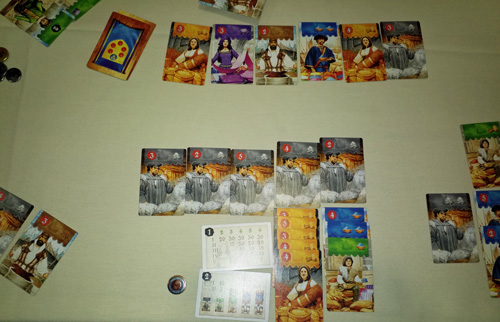
Playing Medici: The Card Game – I seem to have a ship full of furs (grey)
The cards represent goods of five different types in various values - plus high value cards that are not goods. (The card game has some extra cards - passengers - which don't take up room in players' ships.) Players take cards to fill their 'ship'. Once all ships have been filled, players score for the most valuable ship and then for the most of each good. The first part of the scoring is round by round, but the second builds up across the rounds, with bonuses for reaching high amounts of a good.
The first thing players do is draw up to three cards from the deck and place them face up in a row. In the original game, the set would then be auctioned. In the card game, the player must take the last card they turned over and may take either or both of the previous two cards - if they have room in their ship. In fact, a player doesn't have to turn over any cards, they can just take card/s from those already on the table.
The aim remains the same however: making up valuable ships and collecting sets. One odd point about the card game is that the lowest denomination of coin (used for scoring) is a '5'. When positions are tied, the rewards for players are added up and divided between those tied. However, if the result is less than five, players get nothing. I don't know whether this is a design decision or just that the publisher couldn't fund '1' coins as well (I blame Kickstarter).
Anyway, the result is a good game that preserves much of the clever original. I quite like the new card-taking mechanism, which I know will go down well with those who found Medici's auction too brain-melting. Medici: The Card Game gets 8/10 on my highly subjective scale.
5: Rosenberg and Stockhausen
Pete and I were still partly in a different time zone and getting up quite early each morning. On Friday one of the few people in the main room when we arrived was Bill Masek - another old gaming buddy and one of the few people who've attended every Gathering. Bill fancied giving Alien Artifacts a go and we were happy to oblige. Designed by Marcin Senior Ropka and Viola Kijowska, it's published by Portal. Pete and I tried the prototype at last year's UK Games Expo (see my Expo report and TWJO 176) and it doesn't seem to have changed much in the interim.
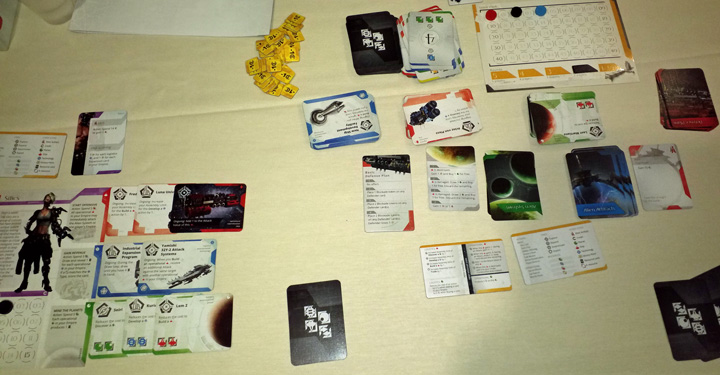
Playing Alien Artifacts: that’s my player board bottom left, with my deployed ships, technologies and planets to its right
It's an exploring-the-galaxy game, but without a physical board or tiles to explore - that's abstracted to spaceship, planet and technology cards. Players' actions are powered by their hand of resource cards, the types of resource matching with spaceships, planets and technologies (plus a wild resource). First, however, players must buy cards, using their money (a track on players' boards shows this) and placing the cards to the left of the player board.
Resources of the matching colour are then used to shift cards to the other side of their board: deploying ships, developing technologies and discovering planets (it's a 3D game as well as a 4X!). In each case, the card has different effects depending on which way up you place it. Thus a planet can give a permanent discount when spending one type of resource or one-off production of resources. Players can score points during the game - notably by attacking the current 'Alien planet' card - but get more points at the end for all their ships, technologies and planets, plus any points from specific technologies.
As you can only take one action in your turn, the game moves along at quite a pace. Despite having played it a couple of times now, I still don't understand it. Looking at what ships, technologies and planets do, I'm sure there are multiple strategies in the game and players will find additional depths as they play it. However, it didn't grab me enough to particularly want to play it again. Alien Artifacts gets 6/10 on my highly subjective scale.
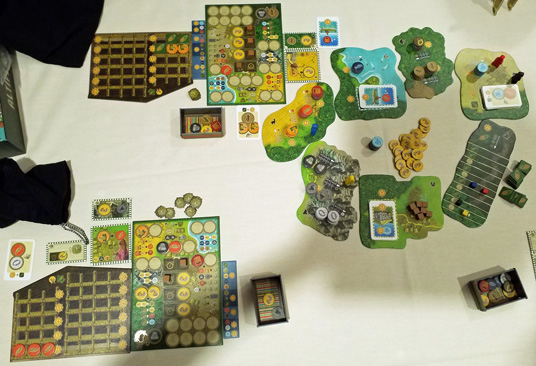
Altiplano in play – I still don’t know what’s going on
One of the games I've been wanting to play since last October's Spiel is Reiner Stockhausen's Altiplano (published by dlp). Pete and I grabbed a copy for Leo, who'd played it before, to explain. Corbin Nash made a fourth. I found the game a bit overwhelming at first, as it's not immediately obvious what you should be doing - and there are a lot of choices. The main way of scoring points is by collecting goods: there are a dozen different goods, some of which don't actually score, but are useful during the game. However, even these are worth points if they've been stashed in your warehouse or used to complete a contract. Players also get points for their boats and houses and some houses provide bonuses.
So, lots of things that will score points, suggesting lots of ways to play the game. It's played over seven locations - each its own small board - set out in a ring. Each is a source of certain goods and allows players to take specific actions. So, the key thing in your turn is moving your pawn around the locations to get the actions you want. Ideally, you've planned this to get the most efficient sequence. However, players' actions are powered by the chips they draw from their bag at the start of their turn. Thus, what you are able to do depends on what you draw - though you can place chips for use in a subsequent turn. What's more, chips don't get used up, but go back in the bag along with any new ones. Yes, it's a clever variation on deck-building.
Most of the actions generate goods, but players can also build boats and houses, increase their movement and the number of chips they draw, store goods in their warehouse (bag management!), fill contracts and so on. The goods you take then provide you with more options in subsequent rounds, once they come back out of the bag of course. Once I'd got past my initial confusion, I really enjoyed Altiplano. It has some clever ideas, provides different ways to play and rewards planning. It gets a provisional 7/10 on my highly subjective scale and I look forward to playing it again.
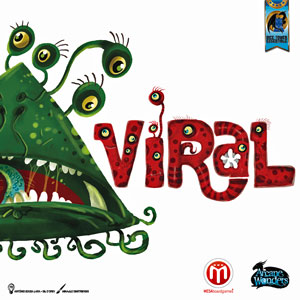 It was then my turn to teach again as I introduced Leo and Corbin to Viral - Pete and I played it first at Spiel last year and I've since been playing it at Swiggers games club. You'll find my notes about it in my Spiel report and in TWJO 180. Designed by Gil d'Orey and Antonio Sousa Lara and published by MESA, it gets a solid 8/10 from me.
It was then my turn to teach again as I introduced Leo and Corbin to Viral - Pete and I played it first at Spiel last year and I've since been playing it at Swiggers games club. You'll find my notes about it in my Spiel report and in TWJO 180. Designed by Gil d'Orey and Antonio Sousa Lara and published by MESA, it gets a solid 8/10 from me.
After dinner, Pete and Leo went to play Commands & Colors: Ancients and I got try Nusfjord with Kris Gould doing the explaining. Joining us were two veteran Gathering attendees, Don Dodge and Doug Walker. Nusfjord is one of Uwe Rosenberg's 2017 games and was published by Lookout/Mayfair. Once it's laid out, it's clear the game has quite a few familiar-looking elements. Each player has their own board with spaces for buildings (among other things), most of which start off covered by forest tiles. Removing these will produce some useful wood tokens, of course, but it may also be worth retaining some forests.
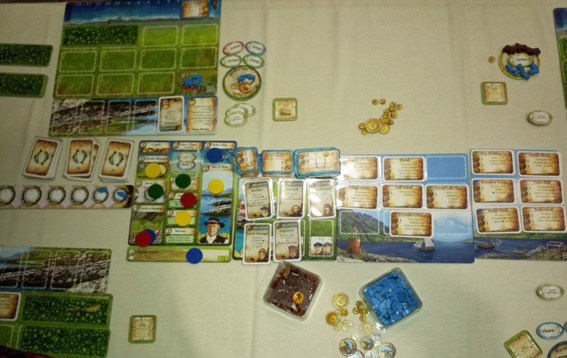
The main board in Nusfjord with a player’s board in the background
The boards also have spaces for village elder cards, providing extra actions, and for the player's fishing boats, which produce fish each round. And you can never have too many fish. Actually, you can: players can only hold a certain number. This is a shame as you may be able to turn a heap of fish into a pile of gold. Gold is worth victory points, but is also used - along with fish and wood - to build buildings. Buildings provide victory points, an immediate bonus or a lasting effect.
Nusfjord is, of course, a worker placement game. Players have just three wooden discs in their colour to place on the action spaces. These let you build buildings and ships, add an Elder to your display, turn fish into money, produce wood, re-forest your board, issue shares to gain money, buy shares to get fishy dividends. Elders you hold are also be action spaces. And there's a very useful action space that lets you copy another action when someone else has already taken it.
While there are plenty of options for what to do, I didn't find this as overwhelming as Altiplano. Partly, this may well be because many of the game's mechanisms are familiar from Herr Rosenberg's earlier games. However, while his designs have been getting more and more complex (see A Feast for Odin), Nusfjord is simpler again. This does not mean the game is less challenging, it's more that it's boiled down, condensing gameplay into a smaller package. It gets a provisional 8/10 on my highly subjective scale and is another game I'm looking forward to playing again.
My last game of the day was a three-player game of Keyper with Pete and Mike Allen. It seemed to work just as well as the four-player game.
6: Flea market, prizes and more games
The first order of business on Saturday is the flea market. This takes over the main room for a couple of hours as people offer second-hand games (and other things). I find it a real nostalgia trip as I spot lots of games I haven't seen for years. It's also a chance to say hello to some of the people I've missed so far - both those behind the tables and those milling around, browsing. There's often the odd gem for sale, but transatlantic luggage limits mean I'm not buying much. I did pick up a copy of Little Devils, though, having enjoyed it a couple of days before.
Next up was a game of Rajas of the Ganges with Pete, Nick and Mike (designed by Inka and Markus Brand, it's published by R&R in the US). This was another game that I first played - in prototype form - at last year's Gathering. It's a neat dice and worker placement game in an Indian setting. Players have their own board, onto which they'll place the buildings they buy, connecting roads to get bonuses. Buildings generate money and/or fame. Both of these are tracked, in opposite directions, on the main board and the game end is triggered when a player's fame and money markers meet. The winner is the player whose markers are furthest past each other (or, as was carefully pointed out to me, who has the highest total of game and money).
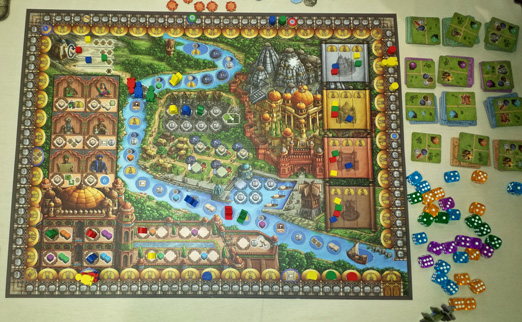
The main Rajas of the Ganges board, building tiles and lots of dice
Adding a building to your board is done by placing a worker on the appropriate position on the main board and paying dice of the right colour and value. This action puts a premium on higher value dice, but others use low values. For example, moving along the river Ganges - a track that winds across the board - uses only values 1-3. This action brings useful bonuses and moving far enough along the track is one of the ways of getting another worker pawn. And if the dice are all just wrong, you can spend a 'karma' to invert one.
There are quite a few action sections on the main board, but they all boil down to getting more money, fame or dice. It's the dice that provide an extra dimension to the game. Not only do you have to make the most of your workers, you have to manage your stock of dice, too (carefully arranged on your cardboard cut-out of Kali) - the river bonuses can be really useful here. I thoroughly enjoy the challenges of playing Rajas of the Ganges and it gets 8/10 on my highly subjective scale.
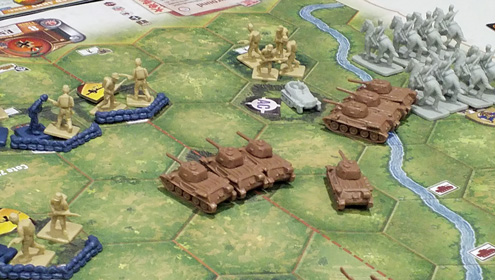
Russian tanks – supported by cavalry! – make an early attack on their right flank
Then it was time for another of my highlights: the annual Overlord game of Memoir '44 (published by Days of Wonder). Overlord puts together two boards from Richard Borg's simple wargame and has a team of four playing on each side: one Field Marshal and three Generals, each in command of one section of the battlefield. Sheila Davis is the driving force behind this, along with her other half, James. For this year, they'd brought along the Overlord version of the battle of Khalkhin-Gol. Strictly speaking, this is just before World War 2: Russian and Japanese forces fighting it out in Mongolia/Manchuria during the summer of 1939.
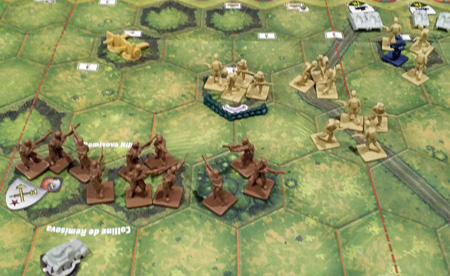
Backed by an armoured car, my infantry take the ridge in the middle
and await the Japanese counter-attack
We drew sides at random and ended up with Rob Simons, James and Terry Egan as the Japanese generals, commanded by Sheila, versus Leo, me and Constantine von Hoffman led by Scott Simon as the Russians. I had the central position of the Russian line, so the main attacks were on the flanks, of course - involving cavalry on both sides (apparently this was the last successful use of cavalry in a battle). Despite this, I was able to take the ridge in the middle of the board and hold it against James's counter-attacks, doing my bit to contribute to a fine Russian victory: 18 medals to 8 on the other side. (Medals are won for eliminated enemy units and captured territorial objectives - such as that ridge.)
Memoir '44 is not a particularly subtle game (the mechanisms tend to favour the attacker and the luck element - in cards and dice - is huge), but it is great fun. Playing an Overlord game is a rare chance to play a wargame in teams and I thoroughly enjoy it.
After we packed up, James and Sheila got out Chariots of Rome (designed by Sean Young and published by Victory Point). Leo and I remained with them to try this (I had thought about backing it on Kickstarter, so was interested to see how it had turned out) and Mike Allen joined us. Gamers who've been around for a while will remember Avalon Hill's Circus Maximus, which was packed full of detail and specific mechanisms for determining, for example, just where debris lands. Chariots of Rome could justifiably be described as Circus Maximus-lite.
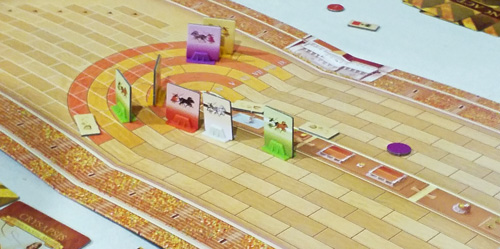
Heading for the finish in Chariots of Rome – the remains of three chariots litter the track…
We played with two chariots each, a recipe for maximum mayhem. The game is driven by cards, starting with the order of play each round being decided by drawing the chariot cards at random. When it's your chariot's turn, you set its base speed and may then roll a die to speed it up - though this reduces your horses' endurance (lose too much endurance and you're out). Then you have to move the resulting number of spaces. This is not a problem along the straights, though you may have to weave around other chariots. However, going over the printed speed in the lanes around a corner means drawing cards to see what bad things happen.
Along the way, you are allowed to make one attack on a chariot you pass: either ramming it (though this can damage your own) or whipping it. Again, players draw cards to discover the effects of the attack. As far as I can see, the best tactic for winning this game is to move first - or at least early - each round. Having played other chariot racing games, this one is too random for me. Chariots of Rome gets a provisional 5/10 on my highly subjective scale.
An early dinner was next on the agenda and Pete and I adjourned to the Third Street Retreat to sample their craft beers. Oh, and their non-breakfast menu, of course. See the box for my notes on the beers. We were joined by Dan and Julie Luxenberg, which made for a fun meal.
Saturday evening is essentially the climax of the Gathering. The ice cream social (mmm, ice cream...), sponsored by Jay Tummelson of Rio Grande, precedes Alan's thank-you speech (which he keeps brief) and the prize-giving. There are prizes for everyone, though. The way it works is that everybody (or at least those who want to be involved) brings a game as a prize - of a quality that they would like to take away with them. Then everybody, in a random order, gets to pick a prize. To this are added donations from games publishers, which meant that this year we all got three things from the tables. It's a brilliant idea and one I heartily endorse.
Once everybody had stashed their loot, it was time for another game. Clans of Caledonia (designed by Juma Al-JouJou and published by Karma Games) is another game launched at Spiel '17 that I hadn't played yet. Dan took on explaining duties with support from Pete and Julie as they'd all played before. The basic idea is that you're placing your different shaped pieces around a representation of the Scottish Highlands (and lochs) to produce stuff that will score points - either directly or as part of some other mechanism. Points are also available for achieving the goal on each round's tile (a random selection at the start of the game).
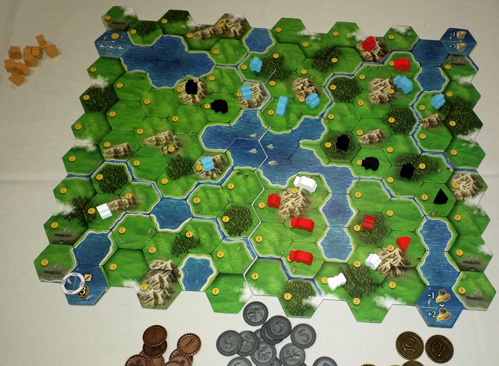
Clans of Caledonia in progress
It's an intricate game as players have lots of different wooden pieces: wedge-shaped for cheese dairies, cow-shaped for cattle and so on. Once placed on the board, each piece produces what you'd expect at the end of each round. Thus a cow produces milk; a dairy produces cheese - but only for each milk it uses up. Goods can be bought and sold at the market, affecting the price of that good, and can also be used to fulfil 'Export Contracts' (tiles). I found that having a Contract gave some focus to what I was building.
Another important element of the game is shipping: how far away you can place pieces along the rivers and across lochs. This is also significant at the end of the game, when players score for how many connected settlements they have. There's a lot going on in this game and it took me a couple of rounds to get to grips with it. However, it's played over just five rounds, so it goes pretty quickly. The variety of options suggests lots of different strategies are possible and this is another game I look forward to playing again. Clans of Caledonia gets a provisional 7/10 on my highly subjective scale.
Wrapping up on Sunday
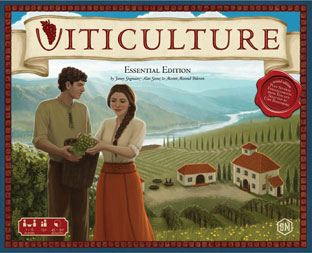 The final Sunday is always the quietest day of the Gathering: some people have left and more are departing through the day (though a hard core sticks around for a final, group meal that evening), so there are lots of goodbyes to be said. In amongst this, I got a game of Viticulture - my first since I played it last year (see my report from
the 2017 Gathering
or TWJO 174) - with Pete, Dan and Julie. This is a cracking worker-placement game of growing grapes and making wine - with plenty of other things to do, too. I got the hang of it again after the first couple of rounds and did okay as Dan held off Pete's end-game scoring to win by a point.
The final Sunday is always the quietest day of the Gathering: some people have left and more are departing through the day (though a hard core sticks around for a final, group meal that evening), so there are lots of goodbyes to be said. In amongst this, I got a game of Viticulture - my first since I played it last year (see my report from
the 2017 Gathering
or TWJO 174) - with Pete, Dan and Julie. This is a cracking worker-placement game of growing grapes and making wine - with plenty of other things to do, too. I got the hang of it again after the first couple of rounds and did okay as Dan held off Pete's end-game scoring to win by a point.
In days gone by, the Gathering was packed with tournaments (and winning one gave you an early pick from the prize table), but nowadays it's almost entirely open gaming. However, one tournament hangs on: Can't Stop, played on Saturday afternoon. I was drawn on a table that included organiser Dan Blum, who duly wiped the floor with us. Playing games with Dan is always fun, but he does have this terrible tendency to win.
Before Pete left, there was just time to play Exxtra, the twenty year-old Reiner Knizia dice game (originally published by Amigo). Eric Brosius, another Gathering veteran, was the man with the game and it was good to be reminded how clever some of Reiner's little games are. It's an 8/10 on my highly subjective scale (and I'm sure I've got a copy tucked away somewhere).
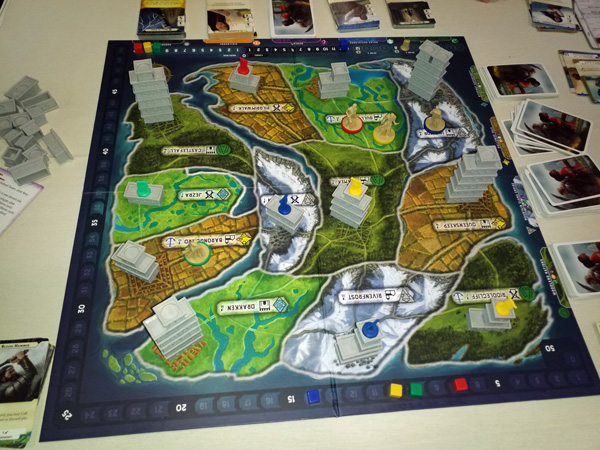
The board towards the end of Path of Light and Shadow: the piles of blocks show
the defence of each area, with coloured markers where a player holds them
My final game was Path of Light and Shadow with Dan and Julie. This is a very new game from Indie Boards and Cards and was designed by Travis Chance, Jonathan Gilmour and Nick Little. The theme is re-uniting the kingdom and the central mechanism is deck-building. Cards represent the different people of the realm, each with their own particular emphasis.
Play is what you'd expect: players use their hand of cards to power actions, then buy new cards and put everything into their discard pile. Then they draw a new hand, shuffling their discards when their deck runs out. The actions let players conquer areas on the board, move their 'Leader' figure (to an area they want to conquer or just recruit from), upgrade cards and remove cards from your deck. It's also possible to build 'structures', which are shown, technology tree-style, on each player's own board. These provide advantages and bonuses, so are well worth doing.
What makes the game different is the morality track. Some actions are considered cruel (culling a card from you deck, for example), others merciful (recruiting an extra card) and both will move your marker one way or the other along the track. Which way you go on the track is a big influence on how you play the game - hence its title. The game is played over twelve rounds and players then score for their cards, allies and structures, with the top level structures also providing bonuses for certain things.
I'm not a great fan of deck-building games and Path of Light and Shadow didn't seem to bring anything new to the table - though the morality track is a neat idea, it didn't have that great an influence over the game. I give it a provisional 6/10 on my highly subjective scale, but I won't be rushing to play it again.
That brought my Gathering to an end, so I made my last farewells. The shuttle took me back to Toronto airport, where there was time for a beer or two before my flight. The return journey was as uneventful as the flight over, though with less movie-watching and more attempted sleep. I thoroughly enjoyed my trip and played lots of interesting games that I hadn't tried yet - though I notice almost all of them were games from 2017, rather than brand new ones. My thanks to Alan Moon and his team for a great time and I look forward to next year - the thirtieth Gathering.
This report was originally published (in an edited form) in issue 174 of To Win Just Once (May 2017).
Photos were taken by Pevans, who played with Photoshop, box artwork is courtesy of the publishers.

